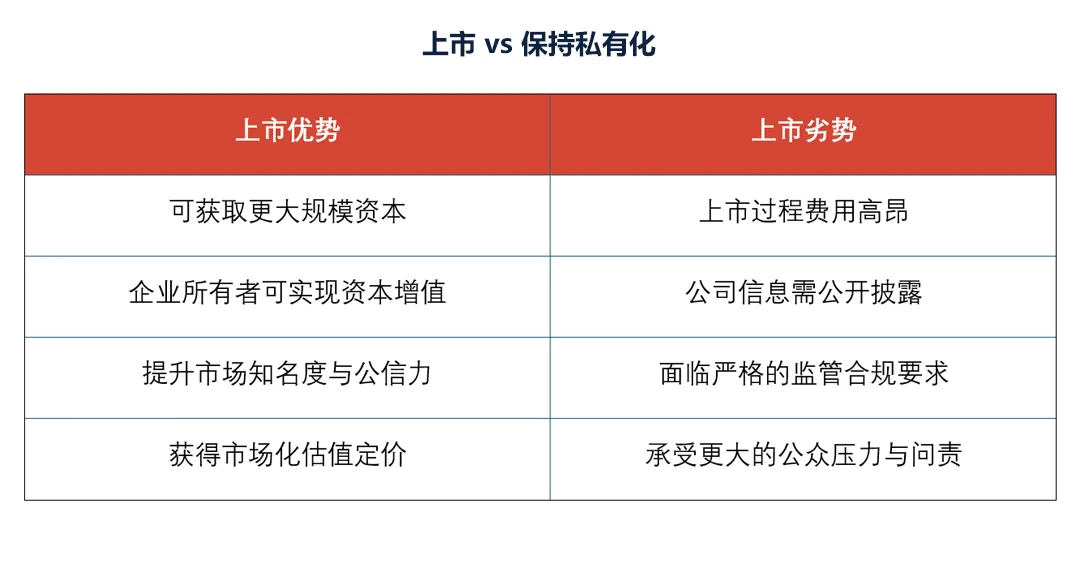

首次公开募股,即IPO,是指私有企业首次在证券交易所向公众发售股票。这一事件标志着企业从私有向公有制的转变,因此常被称为“上市”。IPO为企业提供了筹集大额资金的机遇,可用于支持未来发展或偿还债务,同时也让创始人、天使投资人和家族成员等私人投资者实现投资变现。自2015年成立以来,ARC集团已为超过50个传统IPO项目提供咨询服务,主要集中在纽约证券交易所和纳斯达克市场。
“IPO” 一词数十年来始终是金融界的焦点话题。从某种意义上说,它是企业成功的终极象征,这也解释了为何众多创业者在上市前就以此吸引私募投资者。那么IPO究竟是如何发展的?
自IPO诞生以来,其发行数量与募资规模便持续攀升。早期多为小规模发行,直到1990-2000年代随着微软、亚马逊等数字巨头崛起而迎来重大飞跃。1999年互联网泡沫期间,IPO数量创下当时纪录(457宗),募资总额达983亿美元;进入2010年代,尽管发行节奏趋稳,但凭借Facebook、阿里巴巴等标志性案例,市场仍保持繁荣态势。2020至2021年间,在科技企业与SPAC(特殊目的收购公司)推动下,IPO总量突破千宗,累计募资超2000亿美元。虽然短期受2022-2023年市场波动影响有所放缓,但IPO机制已充分证明其作为资本募集工具的重要性和抗风险能力。
目前美国超过19,000家企业仍维持私有化架构,其中年营收超1亿美元的公司仅有13%(2790家)完成上市。这一数据充分揭示了IPO在资本市场的稀缺价值与受追捧动因。
首阶段工作涵盖战略决策咨询,ARC集团将与贵司紧密协作,通过系统评估企业成长性、市场环境与资金需求,确定IPO是否为最优选择。我们将全程主导上市流程,在确保各环节合规达标的同时,筛选并协调承销商、会计师及法律顾问等核心服务商,让您的团队专注于业务发展。基于对运营体系、财务状况及风险要素的全面尽职调查,ARC将实施关键性优化调整,有效提升投资者吸引力并完成IPO前期战略部署。
企业在申报阶段需编制并向美国证券交易委员会(SEC)提交S-1注册声明书,详细披露公司运营、财务状况、风险因素及募集资金用途。待SEC完成审核并可能要求补充修订后,企业须最终向市场披露包含每股发行价格、发售股份数量等关键条款的招股说明书。
为了吸引机构投资者,公司高管和承销商会进行路演以展示财务业绩和商业计划。通过收集投资者反馈,最终确定发行价格与股份配售方案,同时维持市场认购热度。
IPO当日,公司股票将在纽交所或纳斯达克等公开交易所挂牌交易。当承销商协助股票向机构与散户投资者发行,且股票开始公开交易时,企业正式转为上市公司。
最后阶段需履行持续监管义务,包括向SEC提交季报(10-Q)和年报(10-K)。根据上市规则,内部人士出售股票通常受锁定期限制,公司还需通过投资者关系计划保持股东沟通。为维护投资者信心并确保合规,还可能采取措施控制上市初期的股价波动。
 考虑通过IPO让贵司上市?ARC集团作为全球领先的IPO咨询机构,诚邀与您携手合作—— contact@arc-group.com
考虑通过IPO让贵司上市?ARC集团作为全球领先的IPO咨询机构,诚邀与您携手合作—— contact@arc-group.com

Author:
Yap Juantao
分析师
深入了解我们在资本市场领域的专业服务。
参考资料:
获取我们最新的市场洞察、新闻与报告,以及商业资讯。